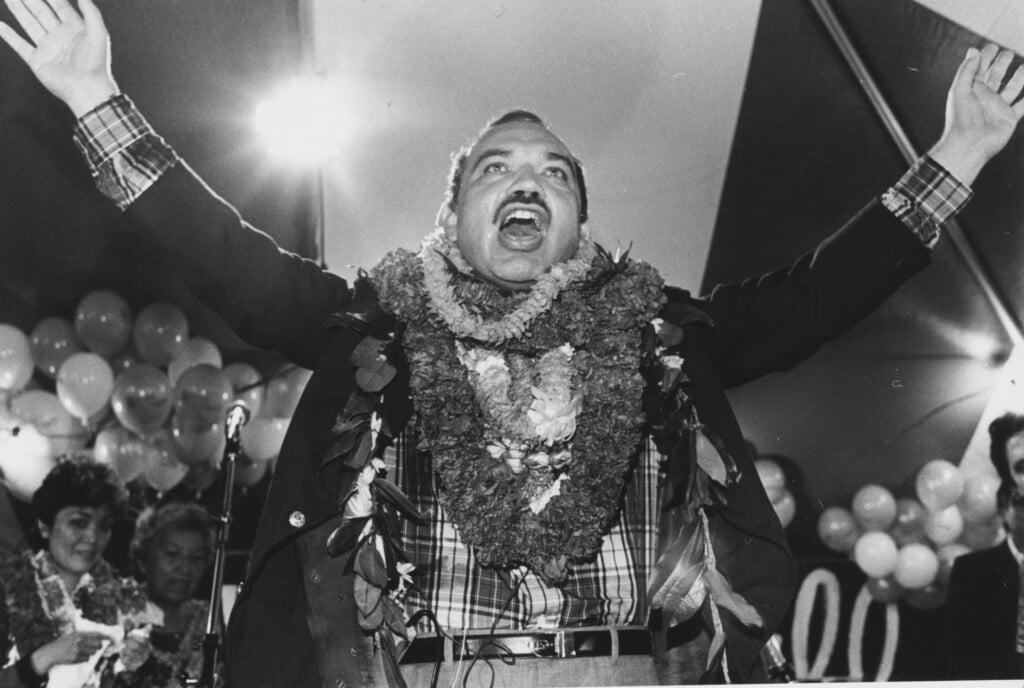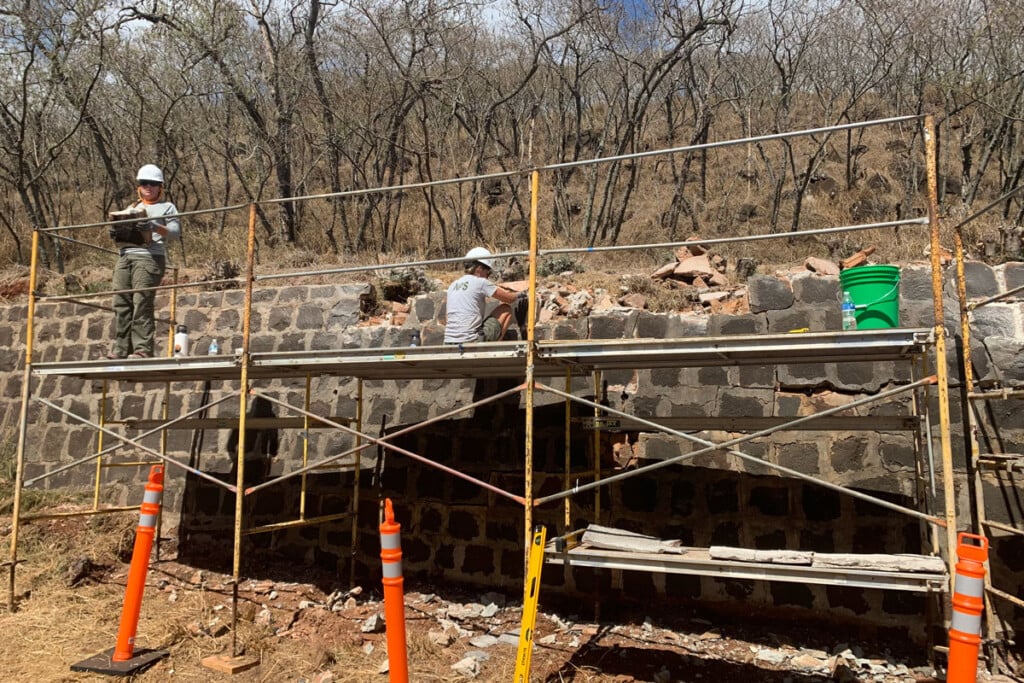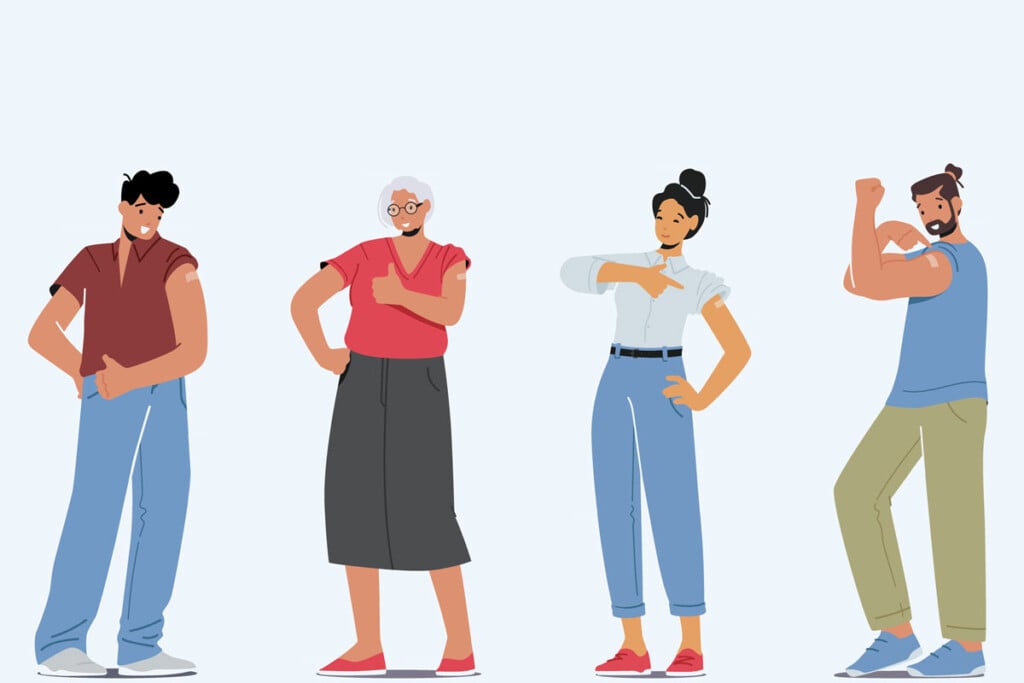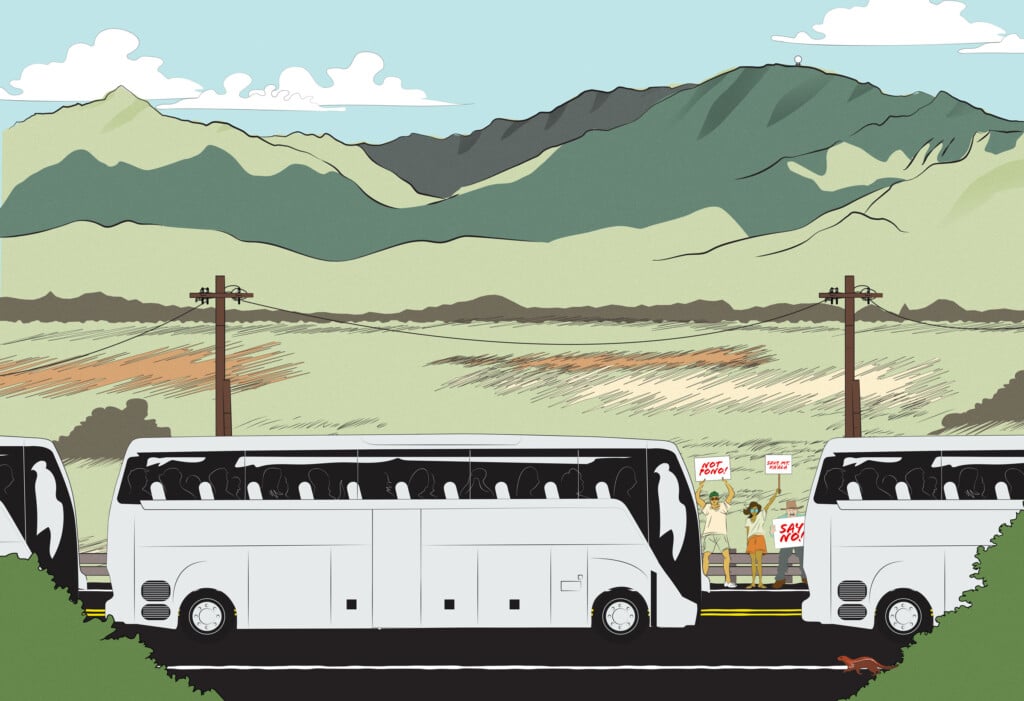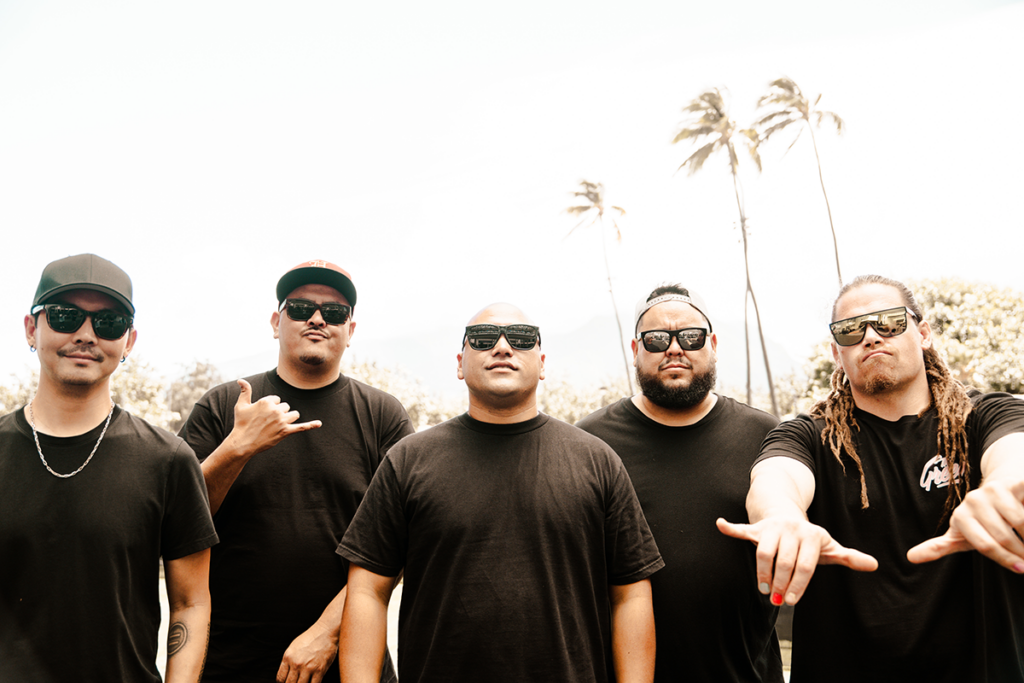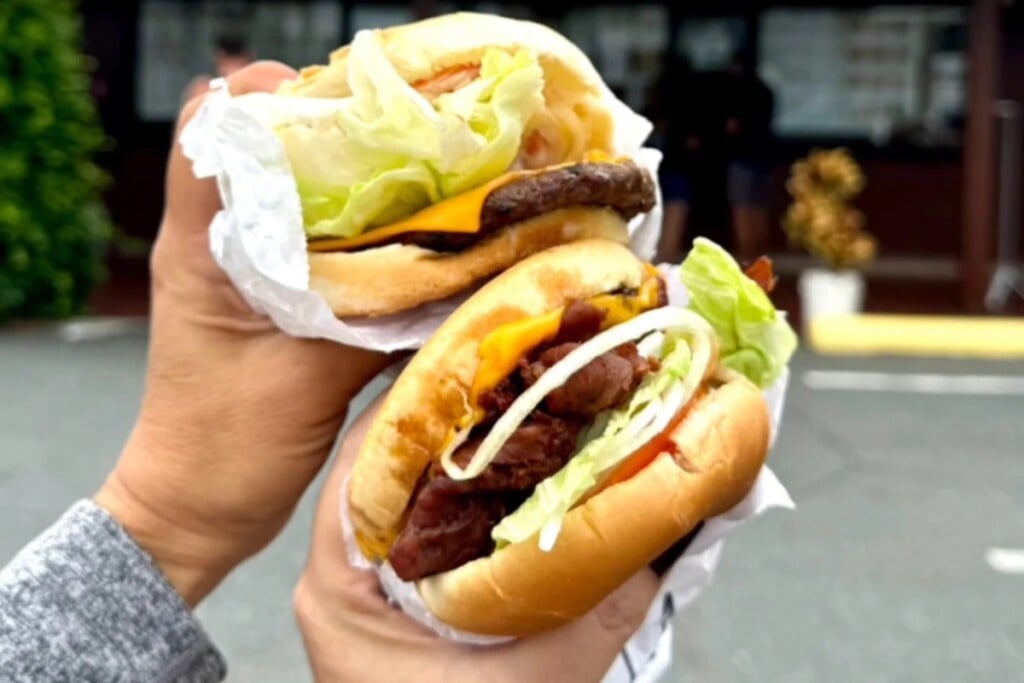Bold Ways to Fix Our City
HONOLULU contributor Mary Vorsino spoke to key leaders about addressing some of Honolulu’s most pressing problems. Here are their ideas in their own words.
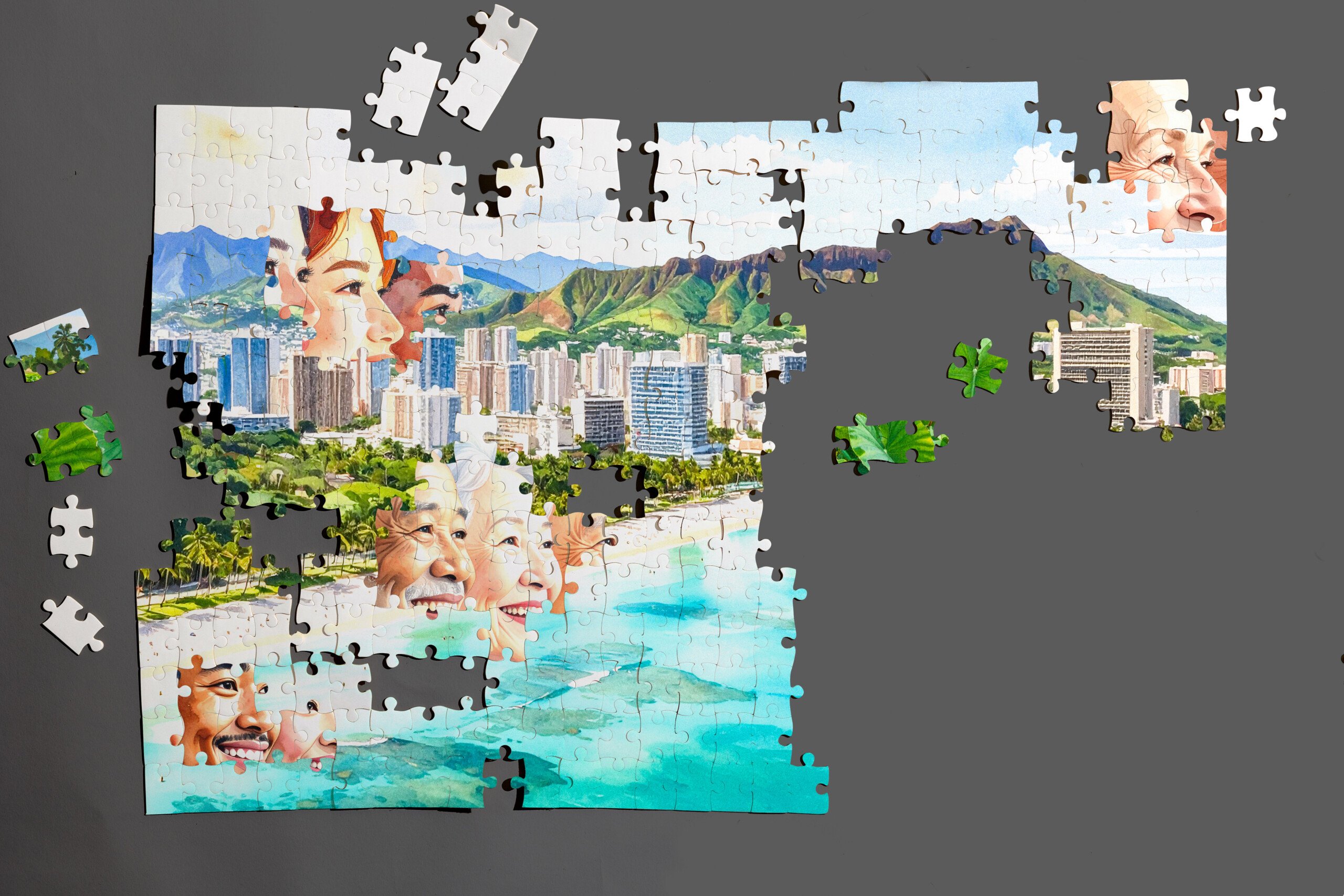
Puzzle photos by Aaron K. Yoshino. Illustrations via Adobe Firefly. Image composites by James Nakamura.
Allow for Disruptive Innovation
Patrick Sullivan | CEO and president of Oceanit

Hawai‘i has long fretted about its overreliance on tourism and the military. The pandemic, which emptied the Islands of visitors, raised new urgency. Yet, tourism and the military still comprise roughly one-third of the state’s economy. Patrick Sullivan, president and CEO of Oceanit, says economic diversification can be achieved, but we must start saying “yes” to disruptive innovation.

Companies that start up here often go elsewhere to grow, and it’s not for lack of capital. It’s because we don’t do things to create opportunities. Energy, aerospace, space and defense, even housing—there’s nothing we can’t do. We have to aim high enough. But we don’t. Hawai‘i doesn’t need to be Texas or Silicon Valley, but we could be much more than we are. We need to find the edge of where the world is and push that edge, not just be satisfied with mediocrity. We need to encourage people to tackle lofty and impactful problems, and the University of Hawai‘i should be pushing the frontiers of engineering, research, physics, computer science, AI, the whole thing.
With Oceanit, we began looking at problems in our backyard but ended up doing things we weren’t comfortable doing because they were hard. Now, we have the ability to move research ideas into real products. We bring things to market at scale. It’s absolutely doable from Hawai‘i.
Once you realize that you’re self-constrained in your thinking and let go of that, things open up. The No. 1 issue when it comes to economic diversification is human capital. We need to let young people know there’s opportunity, but it requires being educated on things that are relevant to them. And once they get to university, we need to expose them to meaningful, meaty problems. Young people are excited to make a difference on the planet, and when given the opportunity, they bring fresh ideas, enormous energy and drive.
We have to make it easier to not only grow a business but make the environment more accepting of those who want to try big things in Hawai‘i. We need to encourage research infrastructure. When our students graduate, they need to be able to pursue ideas that impact not only individuals but society. When you impact society, you create jobs.
Ultimately, though, you can’t do anything if you propagate the idea that you can’t do anything. To break the chain, you have to start early, with kids, but you also have to follow through. At Oceanit, we’ve had almost 800 interns over the years. Early on, those interns learned from their teachers and their parents that if they’re really good at what they do, they’ll eventually have to leave the Islands. There’s nothing here and there’s no future here is the message. And that message has to change.
Empower Communities Through Social Impact Investing
Michelle Ka‘uhane | Chief operating officer and executive vice president of the Hawai‘i Community Foundation

With Hawai‘i’s escalating cost of living, Michelle Ka‘uhane, chief operating officer and executive vice president of the Hawai‘i Community Foundation, sees social impact investing as a solution—deploying capital through very low-interest loans to help first-time homebuyers, providing seed money to farmers and ranchers, bolstering startup entrepreneurs and more.
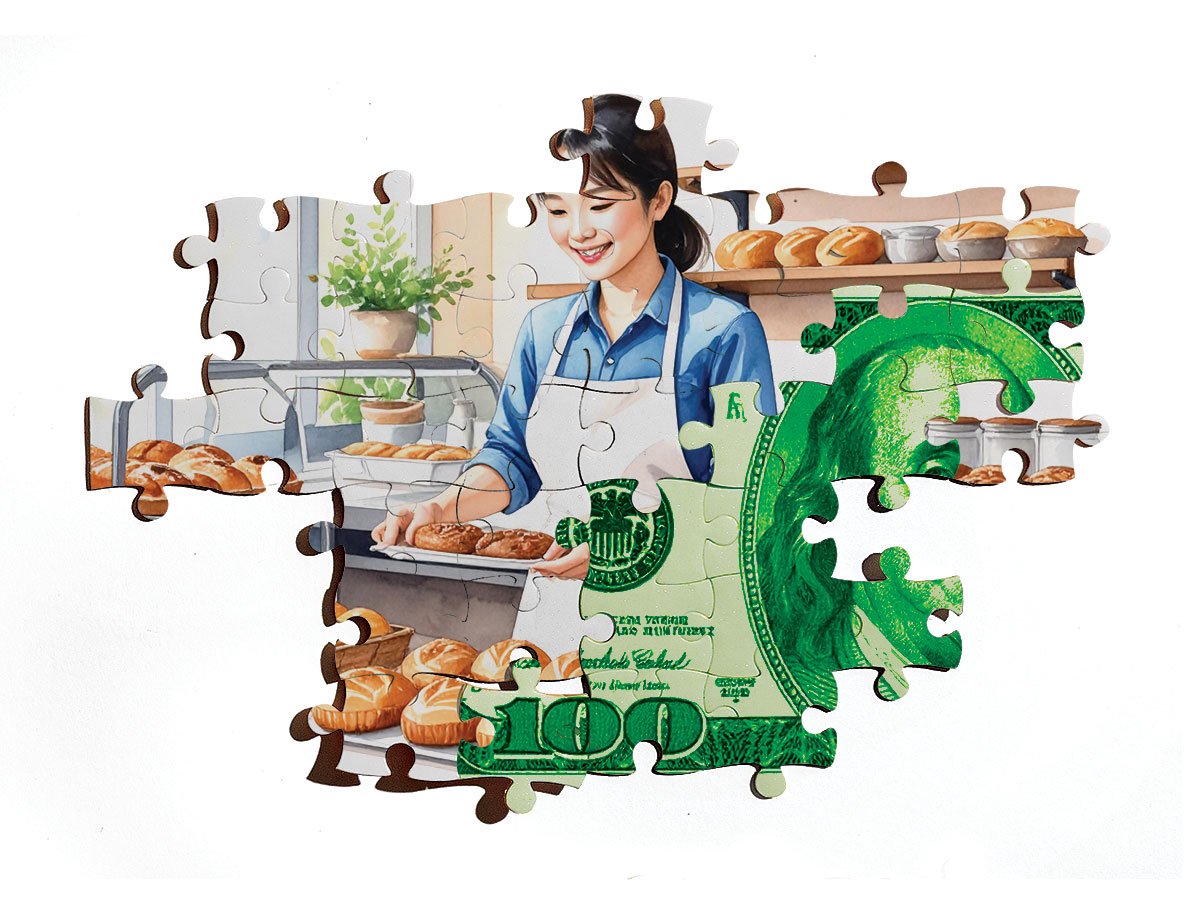
Hawai‘i families are in survival mode, and as the economy softens and inflation grows, families are faced with tough decisions, like whether Mom goes to work or stays home to care for children because the cost of preschool is astronomical. If this continues, the fabric of who we are changes because folks are forced to leave the place they call home.
There are members of our community who need a hand-up—access to capital and opportunities—not a handout. So how do we better address critical issues and connect donors and their resources to the needs of the community?
Social impact investment is a different tool. It’s not just a grant; it’s a loan. HCF started social impact investing as a pilot in 2020, and in three years, we dedicated $5 million for low-interest loans. Our board then approved a permanent program with a $10 million fund. The first loans were to community development financial institutions like Feed the Hunger and Hawai‘i Community Lending, which play critical roles in underserved and marginalized communities where access to capital is limited.
We know access to capital is the lifeblood of any community, for small business startups, credit repair, homebuyer down-payment assistance and housing. Many people outside the system are living paycheck-to-paycheck or relying on payday lending. We need other forms of capital. If you’re not bankable, and as lending criteria gets more stringent, we see intermediaries as critical players to provide access to capital. Put simply, we want an ecosystem of very robust community development.
I’m very passionate about this work. It’s not just about having a safety net, but tools. We should also remember that our community is resilient. We’ve been through four major disasters in six years: the 2018 lava eruptions on Hawai‘i Island, the pandemic, the March 2021 flooding, and most recently now the Maui wildfires. We’re fighting to keep that fabric of who we are as an island state alive. We’re holding on to that for dear life, so I’m hopeful about the movement and the inspiration that’s growing to preserve the Hawai‘i we know and love.
Direct Housing to Locals and Forgive Medical Debt
Josh Wisch | President and executive director of the Holomua Collective

Hawai‘i’s population is dropping as more families flee for lower costs of living and greater opportunities in other states—and Honolulu County is seeing the biggest decline. From 2020 to 2024, the county’s population dipped at an average rate of 0.3% a year, according to the latest U.S. Census Bureau estimates. The Holomua Collective was founded on the belief that a more affordable Hawai‘i is possible. President and executive director Josh Wisch says a future with “more of the same” is unthinkable.

We now have more Native Hawaiians living outside of Hawai‘i than in Hawai‘i. So many people who worked here their entire lives have retired to the continent because they didn’t think their retirement savings would stretch far enough. Everyone has friends and family members who’ve decided they can’t afford to live here anymore, or who’ve realized their standard of living would be much better if they left. I’m not OK with any of that.
The mission of Holomua is to ensure that working families in Hawai‘i can afford to stay in Hawai‘i. We work on everything that deals with the cost of living—and the findings of our most recent cost of living survey were shocking. For example, 70% of respondents said “yes” or “unsure” when asked if they would need to move to a less expensive state. In open-ended questions about what people do to stretch their money, people said things like, “I starve,” and “I’ve decided not to have kids.” It’s heartbreaking.
We’re bringing together people from different sectors to talk about the state’s big challenges and policies that might move the needle. We’re essentially saying, we know all of you have a piece of the puzzle, but everyone is working in silos, so how can we work on the whole puzzle together?
There are solutions. For example, deed restrictions could help keep housing in the hands of local residents and decrease speculation. In other places, homeowners are given grants to participate. In Vale, Colorado, which piloted such a program, residents were given percentages of the value of their homes.
We’re also focused on policies to help people with lower incomes. For example, a proposal was made to forgive medical debt for those earning below 400% of the federal poverty line. If people have delinquent medical debt that results in lower credit scores, they’re knocked out of the economy. And then they have to deal with the downstream effects. It might mean they can’t buy a car, which means they can’t get a job.
Under the program, people’s medical debt would be purchased for pennies on the dollar. When that happens, the debt is forgiven. It’s estimated that around 84,000 individuals in Hawai‘i have $5,000 or more in medical debt; all of them would qualify for the program.
One thing is certain: This is a make-or-break moment for Hawai‘i. If someone is not making enough money to be comfortable, it’s not a stretch to think they’ll have to move away. The first part of dealing with this problem is realizing we have one. We’ve done that, and we now have smart and impassioned people working to make a difference. And that gives me hope.
Support Farm-to-School Efforts
Jesse Cooke | Vice president of investments and analytics at Ulupono Initiative

Despite extensive government and private sector support to bolster agriculture, a “buy local” marketing push and the popularity of farm-to-table, Hawai‘i still imports roughly 85% of its food. While there are bright spots in the push toward sustainability, challenges remain. From 2017 to 2022, about 82,000 acres of farmland and more than 700 farms were lost amid growing market pressures. Jesse Cooke, vice president of investments and analytics at Ulupono Initiative, says building a resilient agricultural industry is possible, but significant investment, policy changes, public support and political will are needed.

We can’t grow everything in Hawai‘i. The cost of land and labor is too high, and land isn’t readily available. As an island state, we have to approach the problem differently and think of local food production as a public security benefit, like a police station or a fire department. Because what if, God forbid, a hurricane were to destroy Honolulu’s port? With no food coming in from outside, and insufficient local production, Hawai‘i would be at risk.
There are barriers, but for our long-term safety, we have to think about food production. We will have a Category 4 or 5 hurricane one day. During the pandemic, store shelves were empty and food banks weren’t able to bring in food from other states. What happens if California has a big earthquake and ports are knocked down? How do we get food here? The state has to think about policies and laws to help local food production.
And we have to think strategically about investments when it comes to food sustainability. We’re never going to be 100% self-sufficient, but we can get to 30%, and that would be a safety net. Priorities could include investments in farming infrastructure, going after more federal grants that support agriculture, and supporting policies that help with housing for agricultural workers.
If we want to get serious about buying from local farmers, one of the biggest things the state could do is support farm-to-school efforts. School cafeterias are our biggest restaurant chain. We have about 200 school kitchens, and the Department of Education will spend more than $70 million on food this year. The department has a mandate to use 30% local ingredients by 2030; it currently uses 6%.
Investing in farm-to-school would encourage farmers to scale up. And those cafeterias could be staffed by people trained in cooking local food from scratch, so if there’s an emergency, we’d have workers who could feed communities. It would provide farmers a big lift—as much as a 20% lift for many crops. That’s not insignificant.
Create Affordable Housing One Home at a Time
Lee Wang | Executive director of Housing Hawai‘i’s Future

How out of reach is homeownership in urban Honolulu? One recent analysis found that O‘ahu families need to fork over 74% of their monthly income to afford the mortgage on a home with a median price of $1 million. The rule of thumb is that monthly housing costs should be about 30% of one’s income. Lee Wang spent 14 years in real estate and grew so concerned about Hawai‘i’s housing crisis that he decided to make the leap to advocacy. He’s now executive director of Housing Hawai‘i’s Future, a nonprofit focused on ensuring Hawai‘i’s younger residents don’t get left behind.
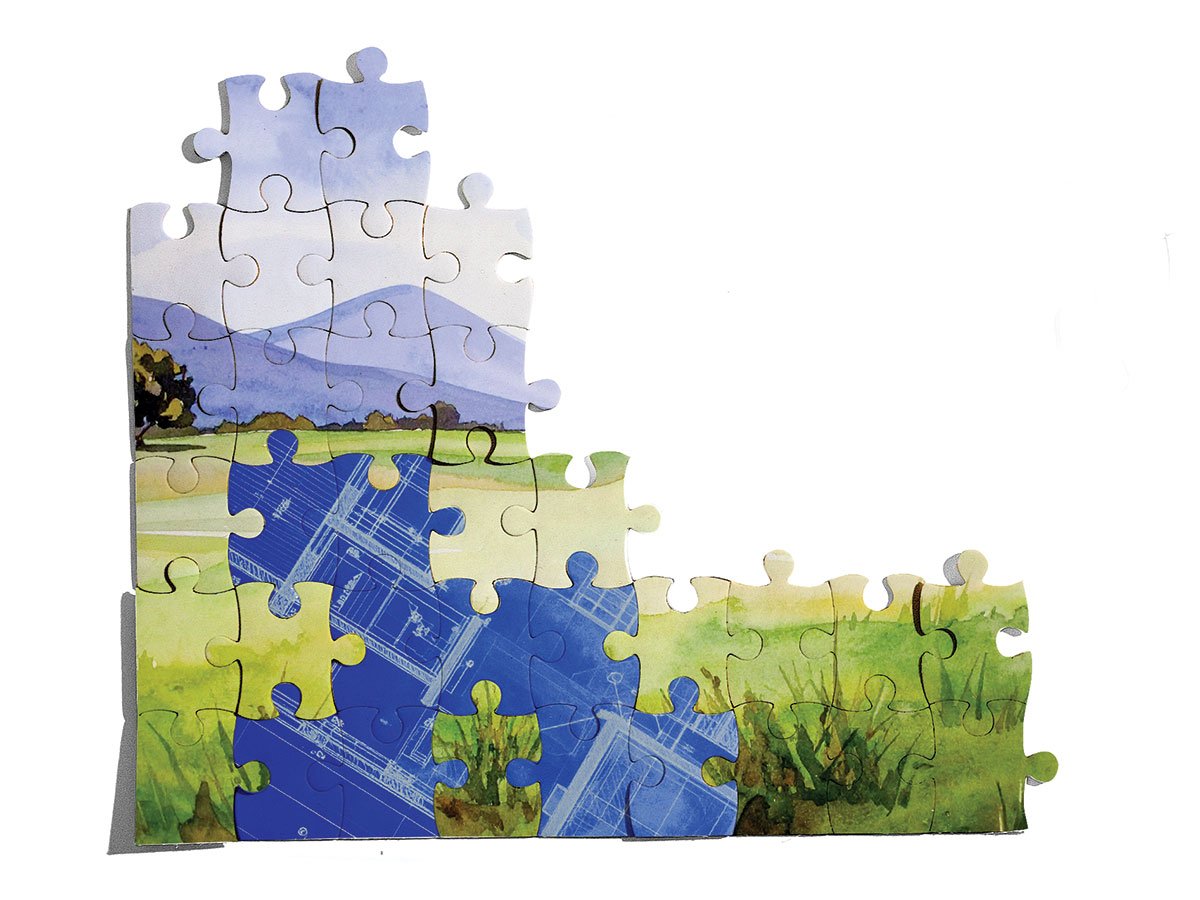
We’re dealing with an affordability crisis in Hawai‘i, and we focus on housing because for most families, it’s their biggest cost. And the bigger that cost, the less there is for childcare, health care and groceries.
The first step is changing the discourse. The natural thing is to simplify the problem, but how we got where we are wasn’t simple. It was death by 1,000 cuts over a long period of time. So when folks talk about affordable housing solutions, they hope there’s a magic bullet. But it’s going to take 1,000 bandages to heal those 1,000 cuts.
If we understand that, it makes the conversation more productive and solutions aren’t knocked down because they don’t solve the affordable housing crisis in one swoop. If we bring to market 2,000, 5,000 or 20,000 homes, and everybody understands it’s not a cure-all, it facilitates the conversation because you’re attacking the puzzle one piece at a time.
Another tactic is deed restrictions in perpetuity, which have been effective elsewhere in the country. The housing crunch is a supply-and-demand problem, and requires two initiatives: One is production, the other protection. The protection portion means that newly built housing goes to folks it’s designed for. The state has this number at 67,400. That’s the number of houses we’re deficient to meet demand. But if we build 67,400 homes today, how many would go to local residents? Probably not all of them, which is why we need production and protecting to work in tandem.
Ultimately, I do believe there’s a solution. The question is do stakeholders have the political will to make necessary trade-offs? It’s hard to quantify the value of aloha, the paradise premium we’re willing to pay. But we can help decisionmakers make more informed choices by asking, is this the price we want to be levying on our youth, or are we going to create a more sustainable path to homeownership, renting and staying in Hawai‘i?
Become a Nexus for What the World Seeks
Peter Ho | Chairman and CEO of Bank of Hawai‘i

Hawai‘i has the highest cost of living in the nation, and Honolulu is among the top 10 most costly U.S. cities. Yet our average wages pale in comparison to places like San Francisco and New York City. In many professions, our salaries are below the national average, a situation Bank of Hawai‘i chairman and CEO Peter Ho says is unsustainable. Ho, who has been outspoken with his concerns, works closely with the Hawai‘i Community Foundation and Aloha United Way to advocate for working families.
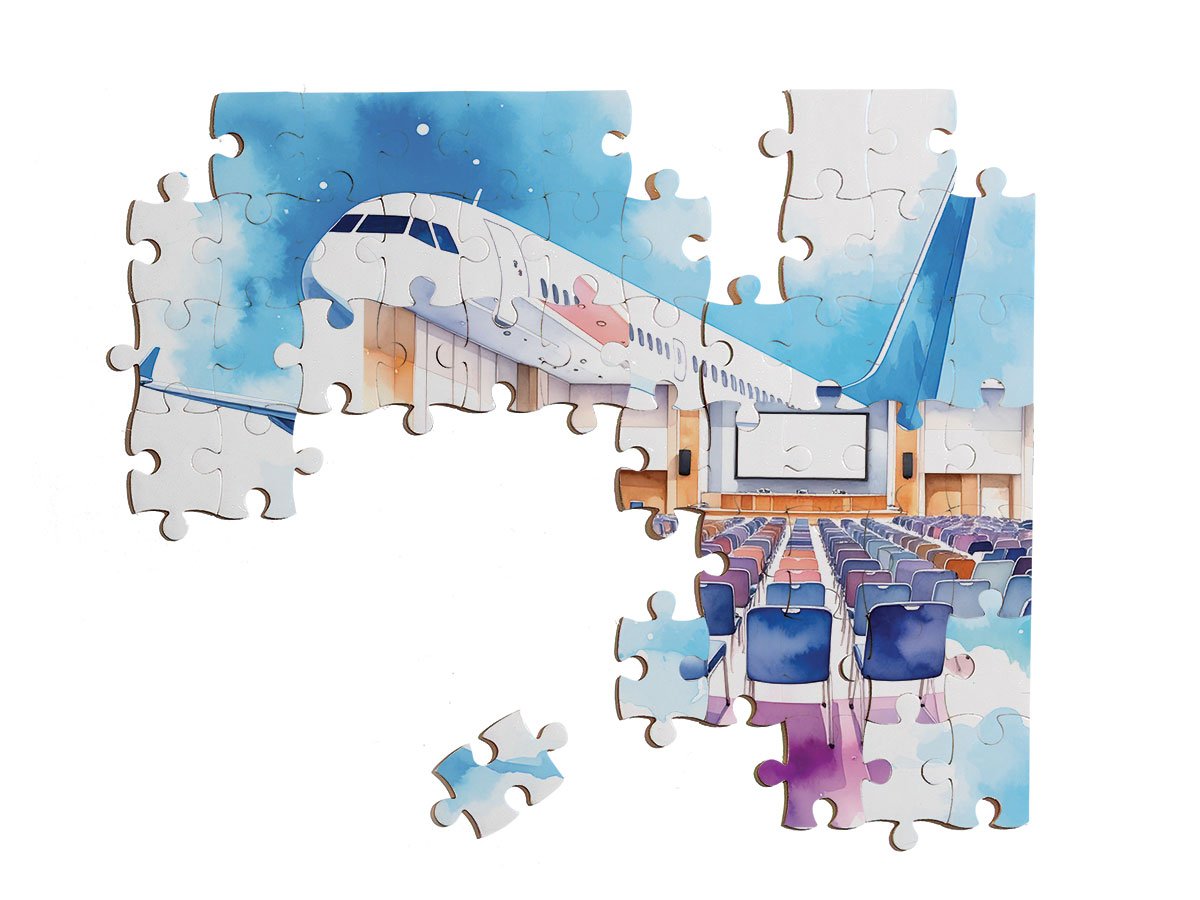
Half of the families in Hawai‘i can’t make ends meet—and that’s clearly not where we want to be. There’s been a concerted effort to improve the situation, mainly through housing. We are making progress, but it’s slow and difficult work. And another watershed moment is emerging. Even if we bend the cost-of-living curve, it’s difficult to generate enough income growth to offset a more inflationary world. We have wonderful industries—the military and tourism—but all economic drivers have their cycles.
When you combine the cost-of-living crisis and income situation, you run the risk of coring out the community. Memories of the community I grew up in are very near and dear to me, and keeping the community the way I remember it is difficult. The vibrancy of other U.S. marketplaces simply doesn’t exist as forcefully here. And there’s more to it than just “I can’t find a reasonable rent.” What’s quickly seeping into this are questions about high-enough paying jobs in the Islands. Can we get enough of them? And is there an ascent to those jobs?
The traditional view is to tackle the cost-of-living problem first, then widen economic opportunities. People have become aware that the cost side is important, but the revenue side is equally so. The world’s a big place, and job opportunities are going to be where value is being created. That’s where raises and promotions come from. We’ve known we’ve had this revenue-side problem for decades, and nothing seems to happen.
It’s important to understand that Hawai‘i has never hoisted its products upon the world. Every opportunity that has come to Hawai‘i—from whaling to sugar to the visitor industry to military—came about from conditions in the world that made the product necessary or desirable. For the visitor industry, for example, our ascent came with the advent of the jetliner. We need to take stock and ask, “How can we create a nexus between what we have to offer and what the world is seeking?”
There are a lot of areas where we could be more productive, including with our two base industries. The visitor industry creates lots of high-quality hotel stock. That’s an asset that could be utilized as a meeting place, geographically positioned between the East and the West. Another area is the military. You have intellectual capital on this Island and the ability to cross-pollinate into other industry opportunities, but we have to cultivate relationships.
This all begins with a recognition that if you don’t do something, you’re going to continue to depopulate. There are all sorts of historic intricacies that play into our opportunities. We need to find the threads and take advantage of them.
Adopt ‘Ōiwi-Led Climate Solutions
Kealoha Fox | Deputy director of the city’s Office of Climate Change, Sustainability and Resiliency

Climate change is a present-tense problem in Hawai‘i, with both rural and urban communities grappling with disruptions to typical rainfall cycles, rising temperatures, shoreline flooding, species loss and wildfires. Along with the hefty price tag for tackling climate change are other costs, such as the loss of favorite surf spots because of rising sea levels. Kealoha Fox, deputy director of the city’s Office of Climate Change, Sustainability and Resiliency, says it’s easy to get lost in the “doom and gloom,” but that Indigenous knowledge and community stewardship offer a way forward.

I entered the climate change space in 2012. I was working for the Office of Hawaiian Affairs, and part of my job was creating the first Native Hawaiian climate strategy. Locally, climate change has been centered on coastal erosion and sea level rise, which is important, but we’re missing other factors. To adapt to global warming conditions, our solutions should be ‘Ōiwi-led through the proliferation of Hawaiian intellect and wisdom.
We’re seeing alarming examples of climate change—king tides, rain bomb events, flooding that washes out bridges and affects entire communities, drought. None of these conditions are new, but we’re now articulating them as climate emergencies. If you think of climate change response as a spectrum, climate mitigation is the reduction of greenhouse gas emissions through public policies and other technical solutions. Climate change adaptation and resiliency is our ability to respond to and adapt to our environment. Climate change shocks and stressors are happening quickly—so quickly that science can’t keep up. Some communities are being hit first and worst, and they’re being left behind in the solutions.
If you focus on the impacts, it can lead to a sense of powerlessness, but we can reclaim our agency. What Native Hawaiian community organizations are doing around climate change adaptation and resiliency is phenomenal—from the restoration of our lo‘i kalo (a traditional irrigation system) to the rebuilding of loko i‘a (fishponds) to the restoration of entire upland forests and their once lost biodiversity. These solutions can be scaled and have the power of community behind them. They’re about finding ways to connect with the land, the natural environment and the resources around us—and that transmits mana.
Last November, voters approved the creation of a city Climate Resiliency Fund and that’s what I’m building now. Voters know we must invest for preventive and ameliorative mitigation and adaptation strategies, and I want to make sure we’re building a fund that sets up a successful road map toward that end. From a Native Hawaiian perspective, long-term health is a collective indicator. To create a climate adaptation movement, people need to feel they’re a part of something bigger.
Bolster Young People with Skills
Michelle Bartell | CEO and president of Aloha United Way

Hawai‘i elected officials, business executives and other leaders frequently mention ALICE when expressing concern about the financial hardships of families. Aloha United Way is behind Hawai‘i’s ALICE—or Asset Limited, Income Constrained, Employed—report; it estimates that 40% of O‘ahu families can’t make ends meet. Many ALICE households comprise younger renters with children. Michelle Bartell, Aloha United Way CEO and president, says the community has to ease the burdens of ALICE families so they can remain in the Islands.

The work around ALICE is among the most important and existential in our state, and it’s one of the reasons I came to Aloha United Way. It’s chilling to think about all the people leaving the Islands. We know the heads of many ALICE families work; they just don’t make enough money to have a basic survival budget. If Hawai‘i’s out-migration continues, we’re going to spiral because the people who are leaving are our workforce. Once they’re gone, our communities won’t have enough police officers, teachers, health care workers. We have to create pathways for workers to remain in the Islands. And we have to show people there’s hope.
One way is to provide more opportunities for young people. We have several programs, cross-sector collaborations and work-based learning opportunities that have potential to be scaled and adopted by other agencies. For example, the partnership between our Residential Youth Services & Empowerment organization and Hawai‘i Pacific Health allows students to earn certified nurse aide credentials, paving the way to careers that offer living wages. It also addresses workforce needs.
It’s important to provide people with skills, like we do with a lot of our programs, and we can do it in a relatively short amount of time. But if we don’t have the political will to tackle issues like the cost of housing, it’s not going to matter.
We just started the third three-year cohort of the ALICE initiative, with 20 nonprofits working in various ways to uplift families. Most of them are social service agencies, but a few are public policy and advocacy organizations. There are some innovative, cross-sector collaborations happening.
One exciting area involves match savings accounts. The Partners in Development Foundation has created keiki assets accounts for educational savings—made possible with seed funding from the federal government. Also being explored is the idea of basic universal income. Such programs have been rolled out elsewhere, and the amount of money awarded to families is just enough to give them a little breathing room.
The cost-of-living crisis is a big problem, but we can tackle it. Hawai‘i as a state has proven it can do hard things. We’ll solve this problem if we keep looking for seemingly small solutions that together add up.
